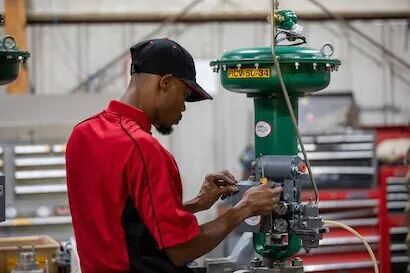Common Issues and Solutions for Industrial Control Valves
Control valves are critical components in industrial settings, but they often encounter problems such as failing to close or open completely, large hysteresis, significant leakage, vibration, and oscillation. These issues can affect the normal operation of the control valves, reduce production efficiency, and pose safety risks. Here is a detailed explanation of these common problems and their specific solutions.
1. Incomplete Valve Closure
Description: The valve does not fully close, leading to leakage.
Solutions: For air-to-close valves, increase the air supply pressure or loosen the spring preload (i.e., reduce the starting pressure of the air chamber) to increase the closing force. For air-to-open valves, increase the spring preload and the air supply pressure to ensure the valve plug fully closes. Regularly inspect and replace sealing components to ensure they are intact.
2. Actuator Rod Movement Issues
Description: The valve responds slowly or not at all, making it unable to control the flow properly.
Solutions: Check whether the diaphragm, rolling diaphragm, or gaskets are aged or ruptured, causing air leaks. If problems are found, replace the aged or damaged components promptly. Keep the actuator rod and other moving parts clean and lubricated to prevent sluggish movements due to increased friction.
3. Excessive Hysteresis
Description: The valve exhibits significant lag in response during opening and closing, affecting control precision.
Solutions: Check if the actuator rod is bent, if the packing gland is too tight (especially graphite packing), and if the valve plug guide is damaged. Solutions include replacing the actuator rod, replacing the packing, increasing the guide clearance, or using a more powerful actuator. Regularly calibrate and adjust the valve to ensure it responds promptly.
4. Insufficient Valve Travel
Description: The valve cannot achieve full open or full close positions, impacting flow control.
Solutions: Loosen the actuator rod connecting nut, rotate the rod outward or inward to adjust the travel, ensuring the deviation is within the allowable range, then tighten the nut. Inspect and adjust the actuator travel to ensure it meets the valve's full travel requirements.
5. Instability at Small Openings
Description: The valve is unstable at small openings, leading to flow fluctuations.
Solutions: First, check if the flow direction is incorrect or if the valve is oversized. If issues are found, adjust to flow-to-open installation or reduce the valve plug size. Select the appropriate valve type and size to ensure stability at small openings.
6. Inconsistent Valve Operation
Description: The valve operates inconsistently, causing flow fluctuations or control failures.
Solutions: This may be due to positioner malfunctions, air supply line leaks, or insufficient actuator rigidity causing insufficient thrust under varying fluid pressures. Solutions include repairing the positioner and air lines or using a stiffer actuator. Regularly check and maintain the positioner and air lines to ensure they function properly.
7. Excessive Leakage
Description: The valve leaks significantly when closed, failing to effectively block the medium.
Solutions: First, inspect the sealing surface for damage, check if the valve seat and stem connection threads are loose, and determine if the closing differential pressure exceeds the actuator's output force. Solutions include replacing the sealing surface, tightening the valve seat, or using a higher output force actuator. Use high-quality sealing materials and components to ensure good sealing performance.
8. Operational Oscillation
Description: The valve oscillates during operation, affecting flow stability.
Solutions: This phenomenon is usually due to the valve operating at small openings or being flow-to-close configured. Solutions include avoiding small opening operations or switching to a flow-to-open configuration. Optimize the valve control strategy and parameters to reduce the likelihood of oscillation.
By implementing these detailed solutions, common issues encountered with control valves can be effectively resolved, ensuring their normal operation and enhancing industrial production efficiency and safety. Additionally, it is recommended to regularly inspect and maintain control valves to prevent problems, thus extending the equipment's service life.
